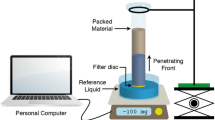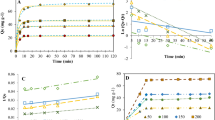Abstract
The influence of whole yeast cells (0–15% w/v) on the protein adsorption performance in dye-ligand chromatography was explored. The adsorption of a model protein, bovine serum albumin (BSA), was selected to demonstrate this approach. The UpFront adsorbent (ρ=1.5 g/cm3) derivatised with Cibacron Blue 3GA and a commercially available expanded bed column (20 mm i.d.) from UpFront Chromatography, Denmark, were employed in the batch binding and expanded bed operation. The BSA binding capacity was demonstrated to not be adversely affected by the presence of yeast cells. The dynamic binding capacity of BSA at aC/C 0=0..1 biomass concentration of 5, 10, 15% w/v were 9, 8, and 7.5 mg/mL of settled adsorbent, respectively.
Similar content being viewed by others
References
Thoemmes, J. (1997) Fluidised bed adsorption as a primary recovery step in protein purification.Adv. Biochem. Eng. Biotechnol. 58: 183–190.
Zhu, J., A. Lyddiatt, A. W. Pacek, and A. W. Nienow (1997) Fabrication and characterisation of agar/zircon sand composite adsorbents for protein recovery in liquid fluidised beds. pp. 103–114. In: A. W. Nienow (eds.).Bioreactor/Process Fluid Dynamics. BHR Group/Mechanical Engineering Publications, London, UK.
Makriyannis, Y. and Y. D. Clonis (1993) Simutalneous separation and purification of pyruvate kinase and lactate dehydrogenase by dye ligand chromatography.Process Biochem. 28: 179–185.
Denizli, A., A. Tuncel, A. Kozluca, K. Ecevit, and E. Piskin (1997) Cibacron Blue F3GA attached poly(vinylalcohol) particles for specific albumin adsorption.Sep. Sci. Technol. 32: 1003–1015.
Dean, P. D. G. and D. H. Watson (1979) Protein purification using immobilized traizine dyes.J. Chromatogr. 165: 301–319.
Gianazza, E. and P. Arnaud (1982) A general method for fractionation of plasma proteins-dye ligand chromatography on immobilized Cibacron Blue F3GA.Biochem. J. 201: 129–134.
Denizli, A. and E. Piskin (2001) Dye-ligand affinity systems.J. Biochem. Biophys. Methods 49: 391–416.
Clonis, Y. D., N. E. Labrou, V. P. Kotsira, C. Mazitsos, S. Melissis, and G. Gogolas (2000) Biomimetic dye as affinity chromatography tools in enzyme purification.J. Chromatogr. A 891: 33–44.
Zhang, S. P. and Y. Sun (2002) Study on protein adsorption kinetics to a dye-ligand adsorbent by the pore diffusion.J. Chromatogr. A 957: 35–46.
Boyer, P. M. and J. T. Hsu (1992) Effect of ligand concentration on protein adsorption in dye ligand adsorbents.Chem. Eng. Sci. 47: 241–251.
Lin, D. Q., H. M. Fernandez-Lahore, M. R. Kula, and J. Thoemmes (2001) Minimising biomass/adsorbent interactions in expanded bed adsorption processes: a methodological design approach.Bioseparation 10: 7–19.
Viloria-Cols, M. E., R. Hatti-Kaul, and B. Mattiasson (2004) Agarose-coated anion exchanger prevents cell-adsorbent interactions.J. Chromatogr. A 1043: 195–200.
Chase, H. A. and N. M. Draeger (1992) Expanded bed adsorption of proteins using ion-exchangers.Sep. Sci. Technol. 27: 2021–2039.
Chamber, G. K. (1977) Determination of cibacron blue F3GA substitution in blue sephadex and blue dextran sepharose.Anal. Biochem. 83: 551–556.
Bradford, M. M. (1976) A rapid and sensitive method for the quantification of microgram quantities of protein utilizing the principle of protein dye binding.Anal. Biochem. 72: 248–254.
Chow, Y. M., M. N. Ibrahim, B. T. Tey, A. B. Ariff, and T. C. Ling (2005) The influence of bakers’ yeast cells on protein adsorption in anion exchange expanded bed chromatography.Biotechnol. Bioprocess Eng. 10: 280–283.
Fernandez-Lahore, H. M., S. Geilenkirchen, K. Boldt, A. Nagel, M. R. Kula, and J. Thoemmes (2000) The influence of cell adsorbent interactions on protein adsorption in expanded beds.J. Chromatogr. A 873: 195–208.
Ling, T. C. (2002)Development of Rapid and Selective Method for the Direct Recovery of Intracellular Protein from Bakers’ Yeast. Ph.D. Thesis, The University of Birmingham, Birmingham, UK.
Author information
Authors and Affiliations
Corresponding author
Rights and permissions
About this article
Cite this article
Chow, Y.M., Tey, B.T., Ibrahim, M.N. et al. The influence of bakers’ yeast cells on protein adsorption performance in dye-ligand expanded bed chromatography. Biotechnol. Bioprocess Eng. 10, 552–555 (2005). https://doi.org/10.1007/BF02932293
Received:
Accepted:
Issue Date:
DOI: https://doi.org/10.1007/BF02932293




